
Shungite Gemstone: Properties, Meanings, Value & More
 Shungite gemstones are rare, black to silver stones found in Russia. For its unique carbon composition, shungite stone is heralded as a “Miracle Stone” in both spiritual and scientific communities.
Shungite gemstones are rare, black to silver stones found in Russia. For its unique carbon composition, shungite stone is heralded as a “Miracle Stone” in both spiritual and scientific communities.
Crystal healers praise shungite, particularly shungite water, for its healing properties. Scientists revere shungite as the only naturally occurring source of unique molecules called fullerenes — more on those later!
Is shungite a gemstone? Jewelers fashion shungite, so it functions as a gemstone. However, shungite is not a crystal or mineral.
We’ll answer all your questions about shungite gemstones in this guide, including the different varieties, healing properties, prices, and more!
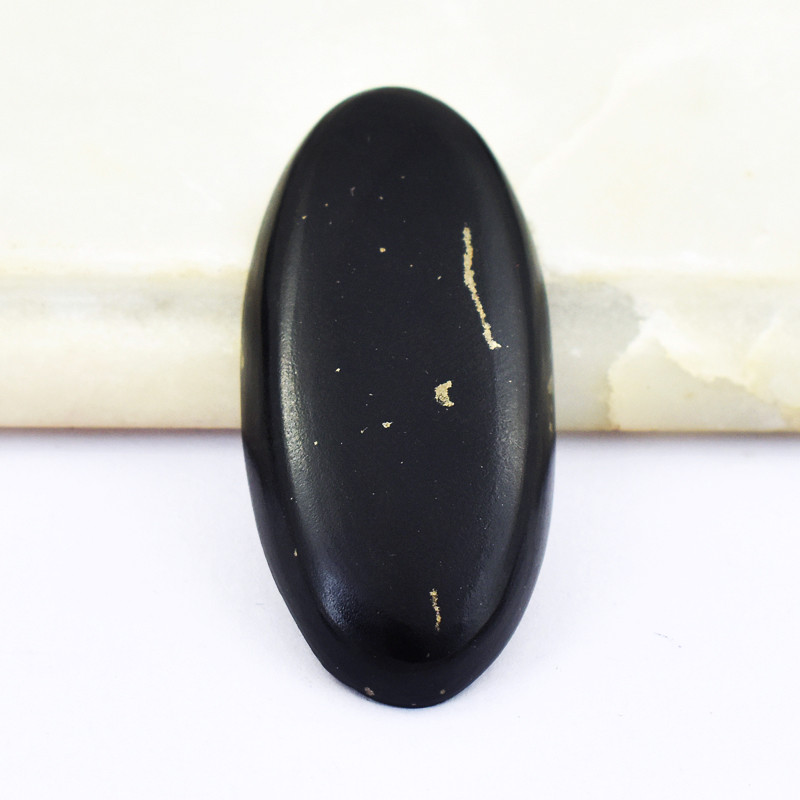
About Shungite Stone
Shungite can be lustrous or matte, and black, gray, or silver. Many consider shungite a semi-precious gemstone.
What is another name for shungite? You may see “Schungite,” “Schungite coal,” or “algae coal.” However, shungite isn’t coal. The terms “shungite natural black” or “carbon black,” refer to paint pigment created from shungite powder, a practice started in the 1700s.
What zodiac is shungite good for? Shungite is a zodiac stone for three signs: Cancer, Scorpio, and Capricorn. The gem is great for balancing Scorpio’s often extreme emotional reactions and helping perfectionistic Capricorns be less hard on themselves. For any timid Cancer, shungite’s solid foundation-building properties support standing up for yourself.
On the planetary side, shungite is a star stone for Saturn, teaching us the value of integrity and delayed gratification.
Shungite Specifications & Characteristics
Shungite is a mineraloid, meaning it resembles a mineral but lacks a crystal structure or definite chemical composition. Shungite always has carbon, but other elements or minerals can be present.
What minerals are in shungite? Some common ones are pyrite, quartz, and mica.
Carbon content in shungite ranges from around 30-98 percent. Most shungite is 30-60 percent carbon.
Carbon molecules in shungite are called fullerenes. A fullerene is a hollow cluster of 60 carbon atoms arranged in a closed-cage (think buckyballs) or cylinder shape. Most shungite has 30-50 percent carbon, but shungite rocks can range from 5-98 percent carbon.
We’ll list the rest of shungite’s properties below:
Color: Black, gray, silver, or deep bronze; May have veins or spots of golden or white from inclusions
Crystal structure: None (amorphous)
Mohs hardness: 3.5-4
Luster: Resinous, sub-metallic, greasy, or dull (in rock form)
Transparency: Opaque
Refractive index: 2.0
Density: 1.84-1.98
Cleavage: None
Fracture: Conchoidal (Type I shungite), granular, or uneven
Streak: Black
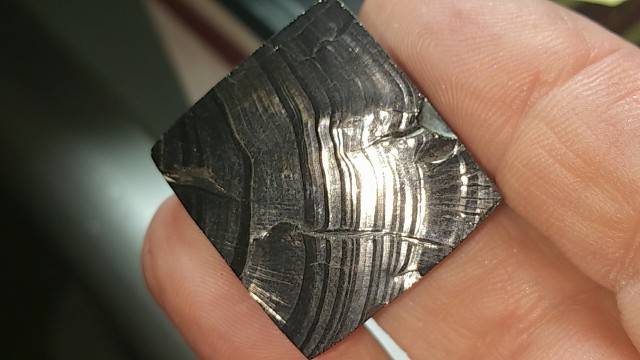
Types of Shungite & Similar Gemstones
There are three main shungite varieties: Type I, II, and III. Sources differ on which variety falls under each classification, but all sources separate them by carbon content.
Type II and Type III are most common for gemstones. Sellers may use the term “regular shungite” for either.
Type I Shungite (Elite or Noble Shungite)
Type I shungite is a silver, glossy, and semi-metallic variety with 90-98 percent carbon. These stones are reflective and smooth like a mirror. They may have terracotta-colored inclusions.
This variety is also called “silver shungite” and “noble” or “elite” shungite. Is “Elite” a shungite name, officially? No, but it’s a common trade name.
Type I shungite only accounts for 1 percent of all shungite, making it the rarest and most valuable variety. However, it’s also the most fragile.
Type II (Petrovsky Shungite)
Type II shungite is a matte, graphite-colored variety with 70-80 percent carbon.
What is Petrovsky shungite? “Petrovsky shungite” and “gray shungite” are names for Type II shungite. The name “Petrovsky” likely honors Peter the Great, a key figure in popularizing shungite.
Type III Shungite (Black Shungite)
Sources differ on whether “black shungite” is Type II or Type III. Plus, some say Type III shungite has 30-50 percent while others say it has 50-70 percent carbon.
We’ll refer to Type III shungite as the classic black form with 30-60 percent carbon.
This variety often has flecks or veins of white or gold and looks shiny when polished. Most shungite gemstones are black shungite.
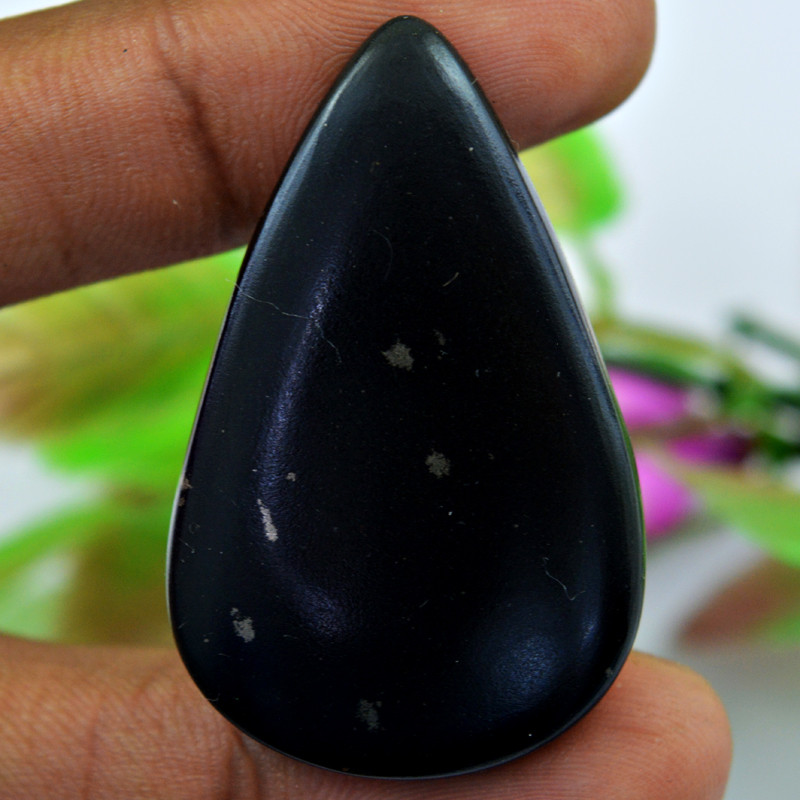
Similar Gemstones
Shungite shares a similar appearance to a few gems, most notably obsidian, jet, and hematite.
Shungite vs. obsidian: Obsidian is an igneous rock composed of volcanic glass. Both shungite and obsidian are black and amorphous. So, how can you tell the difference between shungite and obsidian? Besides their different compositions, obsidian is much denser (heavier) than shungite.
Shungite vs. jet: Is shungite a lightweight stone? Yes, shungite is lightweight, similar to jet. Plus, shungite and jet are both black and carbon-based. However, most polished shungite is somewhat angular, while polished jet is smoother and rounder.
Shungite vs. hematite: How can you tell the difference between shungite and hematite? Hematite is an iron oxide mineral that, like shungite, can conduct electricity. However, hematite has uniform black coloring, while shungite commonly has gold or white impurities.
Now, let’s explore shungite’s rich history!

Shungite Meaning & History
Russian geologist Aleksandr Inostrantsev wrote the first official scientific description in 1879 and named the stone “shungite.” Inostrantsev studied samples from Russia’s Shunga deposit near Onega Lake in Karelia and determined they were a natural carbon different from coal.
Archeological evidence uncovering sacred sites around Lake Onega revealed the area had spiritual significance as early as 6,000 BC. Sámi shamans believe the lake has powerful, pure waters, and they conduct rituals nearby. Starting in the 1300s, churches also set up near the lake to harness some of its ancient, sacred properties.
Therefore, it’s unsurprising that Russians knew of shungite for centuries before Inostrantsev’s discovery. In Russian folklore, it’s called the “Stone of Life.”
Records mentioning shungite, under the name “aspidniy,” first appeared in 1706. Orders from Czar Peter I, or “Peter the Great,” said to obtain aspidniy from Olonetsky for fountains in his Summer Gardens.
Clearly, using shungite stones for water purification was well-established in Russia. Additionally, Peter the Great had his soldiers bring shungite stones to battle for purifying water and preventing infections.
After Peter the Great died in 1725, shungite’s relevance declined until 1930 when Russian researchers began studying it. WWII halted these studies, but they picked back up in the 1960s.
In 1985, scientists discovered shungite’s fullerenes and received the Nobel Prize in 1996 for the discovery.
Fullerenes are crucial to shungite benefits. On that note, what is raw shungite good for?
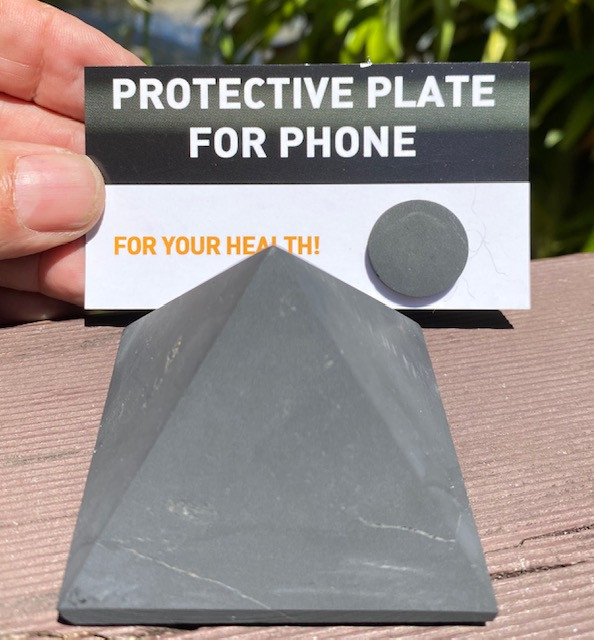
Shungite Healing Properties
All gemstones can be healing stones by nature of their colors and origins. Looking at shungite’s coloring, what are black stones used for?
Black stone uses and benefits include protection, security, and grounding. Just how black objects absorb every color, black gemstones absorb all negative energy.
What are the physical and emotional shungite stone benefits?
Physical Healing
There are many scientific studies on shungite’s physical benefits, all tied to its fullerenes. Some benefits include:
Destroying bacteria and viruses. Based on 2017 scientific review on the carbon nanostructure (CNS) of fullerenes.
Lowering oxidative stress & inflammation. Based on 2017 study on mice that were exposed to UV radiation, then received shungite solution that reduced skin damage and inflammation. (For reference: Oxidative stress is an imbalance of cell-damaging atoms and antioxidants that fight them off).
Purifying water. Based on evidence of shungite removing pesticides and contamination from water in a 2018 study and removing radioactive compounds from water in a 2017 study.
Protection from EMF emissions. Based on protecting rats from EMF radiation in a 2003 study.
Water purification and EMF shielding are the most popular shungite uses. Shungite’s EMF shielding properties may tie to its electrical conductivity. Some claim it’s the best stone for EMF protection and not only absorbs but transforms the harmful energies into beneficial ones.
While more research is needed, shungite stone water likely helps with inflammation and antioxidant production. Scientists hope fullerenes will eventually help treat HIV and cancer.
Emotional Healing
What are shungite rocks good for emotionally? Shungite is said to be very grounding, connecting you to earthly energies and building a foundation for personal growth.
Another purported shungite benefit is emotional stability, helping you make rational decisions and learn from intense emotions instead of being consumed by them. Crystal healers use shungite for promoting mental clarity and optimism in those dealing with stressful financial or relationship struggles.

Shungite Gemstone Properties
To determine a gem’s objective value, an expert examines its value factors, or gemstone properties. Shungite’s value comes from its color, luster, cut, and carat weight.
Color
Shungite can be gray, silver, or black. Higher amounts of carbon create silver, while lower amounts create gray or black.
The most valuable color is silver, as this belongs to the rarest variety — elite shungite. However, luster can go hand-in-hand with color in influencing value.
Luster
Carbon levels also influence shungite’s luster. Higher carbon creates metallic luster. Lower amounts of carbon, along with traces of sulfur, cause a matte appearance. Some shungites look matte initially, but become radiant once polished.
Visible polishing marks from poor polishing can lower value. Generally, mirror-like, metallic luster is most valuable.
Cut
Shungite’s low ranking on the Mohs hardness scale makes faceted cuts difficult and virtually non-existent.
Most shungite becomes a cabochon, possibly oval, pear, and drop-shaped. Jewelers may use cabochons or even raw stones for a shungite pendant.
Other common cuts include shungite beads, pyramids, pendulums, and carvings. Higher symmetry in any cut means higher value.
Carat Weight
Black or gray shungite is available in large sizes, so gem cutters often use this variety for spheres or pyramids. Elite shungite is limited in size, so larger sizes show significantly steeper price-per-carat ranges.
Next, travel back in shungite’s journey to see how it forms!

Shungite Formation & Sources
Shungite likely formed around 2.2 billion years ago during the Paleoproterozoic Era. There are three theories for Russian shungite’s formation:
Layers of prehistoric algae transformed into oil shale, then into shungite because of heat rising from under Earth’s surface
Decomposing organic matter (possibly prokaryotes) in sedimentary rocks combined with silt (deposited sediment) and mud to create kerogen. The mixture sank underground, where heat and pressure compressed the material into shungite.
A carbon-rich meteorite carrying shungite hit Earth and deposited the stone here.
Miners find shungite distributed throughout its host rock or in mobilized sediment. What kind of rock is shungite found in? Shungite host rocks may be sedimentary or volcanic.
Lustrous shungite found in mobilized sediment is called migrated shungite, with two subtypes: layer shungite and vein shungite, respective of where in the rock they’re found.
Mining Locations
Russia remains the most abundant source of shungite. Other reported shungite sources include:
Austria
China
Democratic Republic of Congo
India
Kazakhstan
USA (Michigan)
When exploring shungite for sale, what prices should you expect?
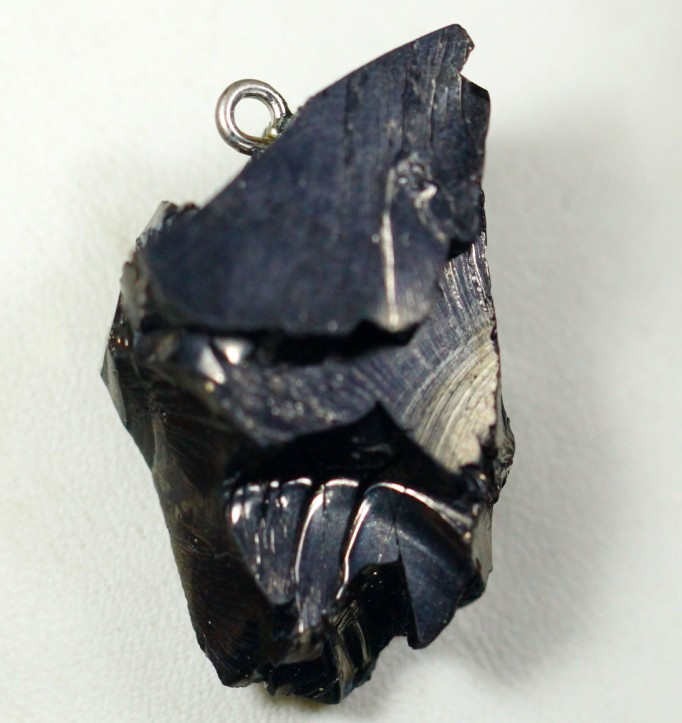
Shungite Price & Value
At wholesale prices, the overall shungite price per gram varies from $0.03-$2 per gram.
The most expensive shungite gemstone is elite shungite. Elite shungite nuggets vary from $0.08-$0.13 per gram for smaller pieces to $0.80-$2 per gram for 100 to 400-gram pieces. Elite shungite beads are around $50-$60 for a 50-bead strand.
Tumbled shungite stones between 2-6cm are typically $0.03 per gram (for a parcel) or around $3 each. Shungite pyramids cost $11-$15 for 50mm heights or $50-$55 for 90mm heights.
Beaded shungite bracelets range from $35-$50 for 14mm and roughly $40 for 16mm. Other shungite bracelets cost $7 to $35. An elite shungite necklace can be $5-$15. Other shungite pendants range from $2-$10.
Shungite Care and Maintenance
Carbon-rich coal ignites, so is shungite flammable? Usually, no. Shungite will only burn at very high temperatures.
Shungite scratches and chips easily, so handle it carefully. We recommend removing shungite jewelry before any activity where it could be hit. Store shungite away from other gems to avoid scratches.
To clean shungite, mix mild soap with lukewarm water. Dip a soft brush into the solution and gently scrub the stone. Rinse your shungite with cool water and pat it dry with a dust-free microfiber cloth.
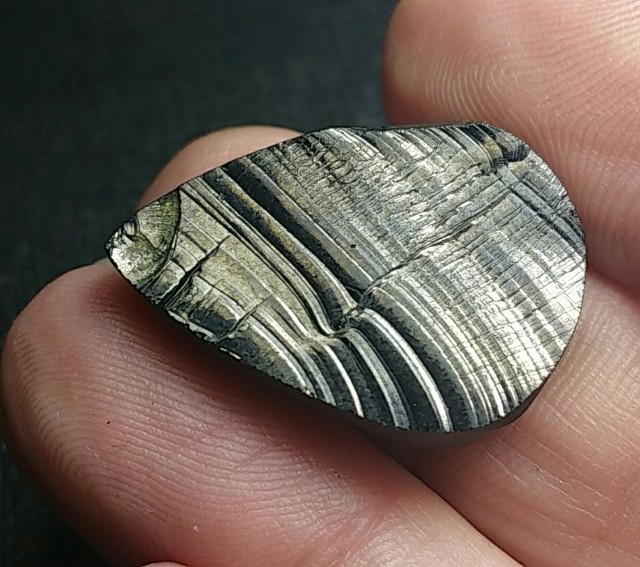
Shine Your Light with Shungite!
Shungite may look unassuming, but it holds mystical powers inside. From roots in Russian royalty to powerful purifying properties, shungite has definitely earned its “Miracle Stone” title.
Don’t just take our word for it — find the shungite stone for you and start feeling its benefits!
Looking for physical and spiritual protection? Buy shungite gemstones today!
Search the Gemstone Encyclopedia
Related Auctions
Related Articles
Originally the Birthstones or gemstones were associated with a zodiac sign or the month of a individuals birth. Find out what your stone is and view the stones we have for sale
8th Feb 2021
There are dozens of quartz and chalcedony gems with various colors and patterns. Learn all about quartz properties and every type of quartz, from amethyst and agate to plasma and phantom quartz!
15th Oct 2020
Hackmanite is a pink to violet sodalite gem known for its unique color-change and luminescence. Learn why hackmanite is special, from its rare qualities to the types of hackmanite jewelry available.
28th Mar 2018
Latest Articles
Yugawaralite is a rare colorless, white, or pinkish zeolite crystal named for its discovery in Yugawara, Japan. Here we uncover the multifaceted history, properties, prices, and uses of yugawaralite.
24th Mar 2025
Simpsonite is a lesser-known mineral known on the gem market for its durability, yellow-orange color, and rarity. Discover all the properties, uses, prices, and history of simpsonite.
3rd Mar 2025
Kurnakovite is a colorless crystal related to inderite and rarely faceted but known among collectors. Explore the mineral traits, history, prices, and more in this kurnakovite guide.
17th Feb 2025
Article Categories
How To's is where you will find helpful articles from gem Rock Auctions on how to cut gemstones, select gemstones and buy gemstones.
9 Articles





